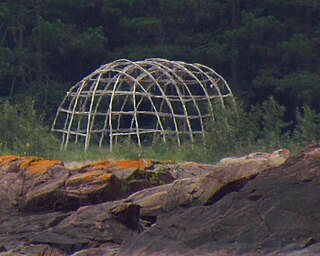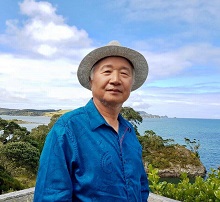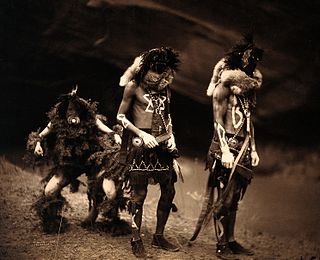
A sweat lodge is a low profile hut, typically dome-shaped or oblong, and made with natural materials. The structure is the lodge, and the ceremony performed within the structure may be called by some cultures a purification ceremony or simply a sweat.

Sedona is a city that straddles the county line between Coconino and Yavapai counties in the northern Verde Valley region of the U.S. state of Arizona. As of the 2010 census, its population was 10,031. It is within the Coconino National Forest.

The Ghost Dance is a ceremony incorporated into numerous Native American belief systems. According to the teachings of the Northern Paiute spiritual leader Wovoka, proper practice of the dance would reunite the living with spirits of the dead, bring the spirits to fight on their behalf, end American Westward expansion, and bring peace, prosperity, and unity to Native American peoples throughout the region.

Siddha Yoga is a spiritual path founded by Swami Muktananda (1908–1982). According to its literature, the Siddha Yoga tradition is "based mainly on eastern philosophies" and "draws many of its teachings from the Indian yogic texts of Vedanta and Kashmir Shaivism, the Bhagavad Gita and the poet-saints." The present head of Siddha Yoga is Gurumayi Chidvilasananda.
A vision quest is a rite of passage in some Native American cultures. It is usually only undertaken by young males entering adulthood. Individual Indigenous cultures have their own names for their rites of passage. "Vision quest" is an English-language umbrella term, and may not always be accurate or used by the cultures in question.

Michael Roach is an American businessman, spiritual leader, and former Buddhist monk and scholar who has started a number of businesses and organizations, written books inspired by Buddhism, and translated Tibetan Buddhist teachings. He has at times been the center of controversy for his views, teachings, activities, and behavior.
Neoshamanism refers to new forms of shamanism. It usually means shamanism practiced by Western people as a type of New Age spirituality, without a connection to traditional shamanic societies. It is sometimes also used for modern shamanic rituals and practices which, although they have some connection to the traditional societies in which they originated, have been adapted somehow to modern circumstances. This can include "shamanic" rituals performed as an exhibition, either on stage or for shamanic tourism, as well as modern derivations of traditional systems that incorporate new technology and worldviews.
The inípi ceremony, a type of sweat lodge, is a purification ceremony of the Lakota people. It is one of the Seven Sacred Ceremonies of the Lakota people, which has been passed down through the generations of Lakota.
Harley "Swiftdeer" Reagan (1941–2013) was an American pretendian and New Age spiritual leader. He is known for founding the Deer Tribe Metis Medicine Society and for developing Chulukua, a martial art, and Chuluaqui Quodoushka, a collection of sexual techniques and theories.
Plastic shamans, or plastic medicine people, is a pejorative colloquialism applied to individuals who are attempting to pass themselves off as shamans, holy people, or other traditional spiritual leaders, but who have no genuine connection to the traditions or cultures they claim to represent. In some cases, the "plastic shaman" may have some genuine cultural connection, but is seen to be exploiting that knowledge for ego, power, or money.
Alex White Plume is the former vice president and president of the Oglala Sioux Tribe of the Pine Ridge Reservation, located on South Dakota of the United States. He served as president from June 30, 2006 to November 2006 after Cecilia Fire Thunder was impeached.

Michael Kabotie, also known as Lomawywesa was a Hopi silversmith, painter, sculptor, and poet. He is known for his petroglyph and geometric imagery.
The Little Shuswap Indian Band is a First Nations band government of a community of the Secwepemc (Shuswap) Nation, located in the Central Interior region of British Columbia, Canada. Its main Indian reserve is in Chase, British Columbia, sometimes marked Squilax on maps is properly called Quaaout, and is on the shore of Little Shuswap Lake. It was created when the government of the then-Colony of British Columbia established an Indian Reserve system in the 1860s.

Lee Seung-Heun, better known as Ilchi Lee, is a South Korean author and the founder of a variety of mind-body training methods, including Body & Brain, Brain Wave Vibration, Kookhak Qigong, and DahnMuDo, all falling under the umbrella name "Brain Education". Lee started teaching his methods in a park in the 1980s, and since then, the practice has developed into an international network of for-profit and non-profit entities. Lee's practices have been criticized as pseudoscience, and his organizations as a cult.

Native American religions are the spiritual practices of the Native Americans in the United States. Ceremonial ways can vary widely and are based on the differing histories and beliefs of individual nations, tribes and bands. Early European explorers describe individual Native American tribes and even small bands as each having their own religious practices. Theology may be monotheistic, polytheistic, henotheistic, animistic, shamanistic, pantheistic or any combination thereof, among others. Traditional beliefs are usually passed down in the forms of oral histories, stories, allegories, and principles.

Archie Fire Lame Deer or Tȟáȟča Hušté (1935–2001) was a US Army veteran, a Wicasa Wakan or Medicine man and a lecturer on Lakota people, traditions and religion. He grew up on the Rosebud Indian Reservation served in the US Army during the Korean war, was a Hollywood stuntman and translator. With Richard Erdoes he wrote Gift of Power: the life and teachings of a Lakota medicine man. He is the son of Lakota medicine man John Fire Lame Deer and the subject of the classic book, "Lame Deer Seeker of Visions” with Richard Erdoes.
The red road is a modern English-language concept of the right path of life, as inspired by some of the beliefs found in a variety of Native American spiritual teachings. The term is used primarily in the Pan-Indian and New Age communities, and rarely among traditional Indigenous people, who have terms in their own languages for their spiritual ways. Native Americans' spiritual teachings are diverse. With over 500 federally-recognized tribes in just the US, while some regional practices and beliefs might be similar, the cultures are highly individualized. Individual ceremonies and particular beliefs tend to be unique to the people of these diverse bands, tribes and nations.

Conrad Robert Murray is a Grenadian-American former cardiologist who was the personal physician of Michael Jackson, providing medical treatment to help him sleep on the day Jackson died in 2009. In 2011, Murray was convicted of involuntary manslaughter in Jackson's death for having inadvertently overdosed him with a powerful surgical anesthetic, propofol, which was being improperly used as a bedtime sleep agent. Murray served a little less than two years out of his original four-year prison sentence.
Chantal Lavigne died in July 2011 in Sherbrooke, Québec (Canada) from hyperthermia and multiple organ dysfunction following an esoteric sweating ritual, which was invented and led by Gabrielle Fréchette, a New Age workshop leader. Her death was the object of worldwide media coverage. The criminal trial ended in the incarceration of the three individuals found responsible for Lavigne's death: Gabrielle Fréchette, Ginette Duclos and Gérald Fontaine.
Bentinho Massaro is a New Age leader from Amsterdam.










